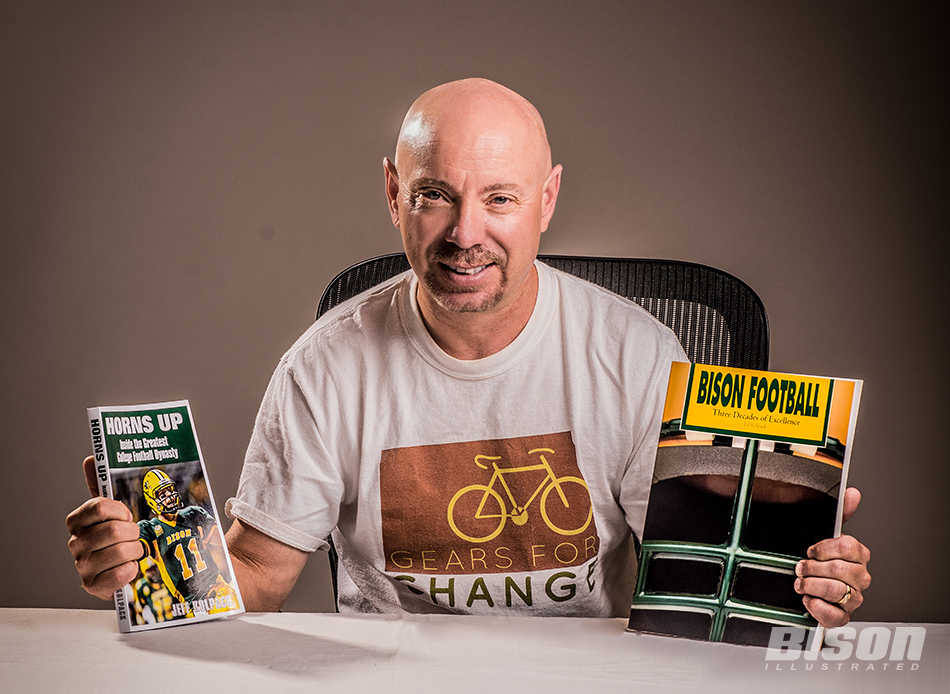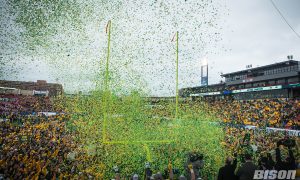By Joshua A. Swanson
Photo by Laura Cramer
Family Legacy
Like father, like son. Looking back at the history, it’s an apt comparison. Jeff Kolpack has covered the meteoric rise of North Dakota State football for the Fargo Forum since the days before the university’s athletic program started its move to Division I in 2002. Kolpack started as the NDSU beat writer for the Forum in 1995. His father, Ed Kolpack, covered the rise in stature of Bison football for the same newspaper from the school’s first national championships in the 1960s to the glory days of the 1980s and early 1990s. If Jeff has cataloged the most successful run in college football history with NDSU’s five straight FCS national titles, Ed was there when the program had its rebirth in the early 60s, which set the stage for today’s success that includes everything from primetime appearances on ESPN, visits from the network’s most iconic show, “College GameDay,” and a national brand rivaling major FBS programs.
While you could say the capstone of Ed’s career covering Bison athletics was the book he wrote on the subject: “Bison Football: Three Decades of Excellence,” chronicling the Herd’s dominating run from 1962 to 1992, there is a new postscript to the encyclopedia of Bison football. Maybe, then, that capstone wasn’t necessarily a single book. The postscript to “Three Decades of Excellence” is a sequel of sorts, out in time for the 2016 football season in the form of Jeff’s book, “Horns Up: Inside the Greatest College Football Dynasty.”
Kolpack’s inaugural book tells the story of NDSU’s transition from Division II to Division I, the years leading to the five straight FCS championships, the FCS championships, and explains how the architects of the Division I renaissance guided the program through a process many thought would end in disaster and built it into the juggernaut we know today.
With a book focused on the program’s architects–particularly the Big Three of Joe Chapman, Gene Taylor, and Craig Bohl–fittingly perhaps, Kolpack did not start out to be a sports journalist or author, like his father. Instead, the younger Kolpack found himself studying architecture at NDSU in the mid-1980s. How, then, did he go from aspiring architect to the chronicler of college football’s greatest dynasty? “I was literally in class one day and I sat down. I go, ‘I don’t want to do this,’” said Kolpack, sitting in a conference room in Downtown Fargo a week before the Bison opener against Charleston Southern. An opener, by the way, that will be televised on ESPN for the second straight year as the network’s college football kickoff. “I got up right when class started and went straight to the registrar and dropped my classes and said, ‘Okay, I got to figure out something else to do now.’” His college roommate made a suggestion that, ultimately, led to his becoming a sports journalist for the Forum and, now, book author.
“My roommate at the time was writing for The Spectrum,” NDSU’s student newspaper, “he goes, why don’t you come over to The Spectrum, I need some help, can you write this story. I can’t remember who it was on, it might have been on Tyrone Braxton,” the Bison defensive back that went on to win two Super Bowls with the Denver Broncos. “So I did it, and I go, well, that wasn’t hard, so I kept doing some stories and then I took a class from Lou Richardson.” Richardson taught journalism at NDSU, retiring in 1993. Kolpack vividly remembers Richardson pulling him aside one day after class as a turning point. “This was really the turning point where I was leaving class one day and Lou goes, ‘Can I talk to you for a minute?’” recalled Kolpack. Kolpack thought he was in trouble. “Oh God, I’m in trouble, I don’t know what I did, but I must be in trouble.” He sure was.
Richardson had some tough words, albeit words of encouragement. “It’s just me and her in the room and she says, ‘What in the hell are you doing.’ I go, ‘What do you mean?’ She says, ‘I see your stuff here, you’re pretty good, but you need some help.’” It was a tough love moment where the experienced journalist and professor told Kolpack he needed to get his, substituting a friendlier word, “stuff together.” “I can never thank her enough for being mean to me. Lou kind of laid it on the line for me. She was very convincing.”
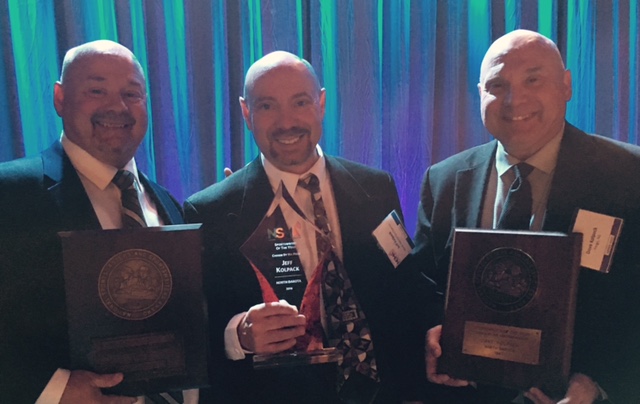
Fargo: Rock City
Kolpack is a busy man nowadays. Between the start of NDSU’s quest to win a sixth straight national championship and covering it for the Forum, “Horns Up” is the hottest book in town. Kolpack is doing the book appearance/media circuit promoting it, including appearances at SCHEELS, Labby’s, and Zandbroz Variety in Fargo, and the NDSU Bookstore tent at tailgating before the home-opener. During the middle of our interview, Craig Haley, the dean of FCS writers and Senior Editor for STATS FCS Football, calls Kolpack to visit about his book for a feature story. Kolpack tells Haley that he’ll call him back and we resume our discussion. We’re in the midst of a wide-ranging, 80-minute conversation that was as unlikely 14 years ago as Donald Trump and Hillary Clinton facing off for the presidency. In 2002, anyone thinking that North Dakota State would win five straight FCS titles eight years removed from the Division II reclassification process (and beat teams like Minnesota, Kansas, Colorado State, Kansas State, Central Michigan, and Iowa State along the way) would have been labeled delusional.
Kolpack began, describing the impact the title runs have had on Fargo, the state of North Dakota in general, and the surrounding region. Kolpack was born and raised in Fargo, attending high school at Fargo South. “Again, I go back to Joe Chapman. Joe Chapman, when they went D1 and were scheduling all these teams because we had no idea, we went to St. Cloud, Mankato, and that was the extent of our travels as media guys. All of a sudden we start going to all these towns and coming back, and go, oh, I kinda see what the president is thinking here that Fargo is probably a little better than we think it is. I think the two biggest things Fargo has ever done, one was build the Fargodome, and two was build their football team to Division I status, no doubt. The first one was in ’93 and look at all the concerts and things. Goose Johnson started the first one. Joe Chapman started the second one.” Johnson was the Fargo Parks Superintendent who, in 1987, spearheaded the proposal that culminated with Fargo’s crown jewel at the corner of 19th Avenue North and University Drive. The next time you crack a cold one at tailgating, consider raising it to Johnson and Chapman.
While Kolpack has covered Bison athletics for the Forum since the days of the old North Central Conference traveling to places like St. Cloud and Mankato, I was a ballboy for Bison football in the mid-1990s. Those were the days of a half-empty Fargodome where getting a ticket was never a problem and there were only a handful of people tailgating in the west lots. In his first seasons as Bison football coach, to encourage attendance at the Dome, Bohl liked to tell the story of how his friend, former Nebraska-Omaha head coach Pat Behrns, would tell Bohl how much he liked playing in Fargo because the Dome was like a big, quiet church. Behrns wasn’t too far off.
My family has had season tickets since the Dome opened for football in 1993. I’ve missed three Bison games at the Dome in those 23 years. The first was in high school when I was playing in a nine-man football playoff game for the Maddock Bobcats. The second was my first week of law school in 2006 at Creighton University School of Law. The Bison played Concordia-St. Paul, a Division II opponent, on a Thursday night. My contracts, property and constitutional law professors wouldn’t take kindly to me skipping that first Friday of classes for a football game. Especially the contracts professor, he did his undergrad at the University of North Dakota. I watched the game via a bad online stream at fellow NDSU alums Dan and Shannon Mostad’s apartment near downtown Omaha. It was one of two games I missed during my three years at Creighton, the other being for my maternal grandpa’s funeral in 2008.
Growing up, I read Ed’s book, “Three Decades of Excellence,” six or seven times. My paternal grandpa bought the book for my dad as a Christmas gift in 1993. I knew that book cold. So cold, the book was partly responsible for my brother and I landing our coveted NDSU football ballboy jobs. You could say it launched my moonlighting as a senior columnist for this magazine. In June 1996, my twin brother, Justin, who is an assistant athletic director for NDSU, and myself were visiting our grandparents in Fargo, coincidentally, our grandparents’ good friends, Paul Tefft and Sherri Schmidt, stopped by for dinner one night while we were staying. Having read “Three Decades of Excellence ” several times, my brother and I, even though in junior high, went on-and-on to our grandparents’ dinner guests about Bison games that happened before we were even born, not knowing that Tefft and Schmidt were, and will always remain, two of the best NDSU supporters ever. (You remember those great parties in Frisco? You can thank Schmidt and Tefft for that.) Tefft was so taken aback and impressed, he told us to be ready the next morning by 8 a.m., he was picking the Swanson brothers up at grandpa and grandma’s because he had someone he wanted them to meet.
That someone was Bison head coach Rocky Hager. Tefft took us to the Dome where Hager gave us a personal tour. Just like the night before, the Swanson brothers had all kinds of questions for the coach we had read so much about. I remember Hager telling us the City of Fargo limited the number of days the Bison could practice in the Dome each year. I told the coach that seemed pretty dumb, as Bison football was the marquee tenant. Hager agreed, telling me I should run for the city commission and set them straight. Exactly 20 years later, I’m having a conversation with Jeff Kolpack, the son of the man who wrote the book that was gospel for a couple young Bison fans growing up in Maddock, N.D. Talk about coming full circle.

“Now Write That Book”
Like “Three Decades of Excellence,” the story behind “Horns Up” took some family prompting from Kolpack’s brothers, Dave and Bruce, to become a reality. In a January 2016 article in the Forum, Kolpack’s media teammate, Mike McFeely, told the Genesis story behind Ed Kolpack’s Bison book. McFeely’s article, “North Dakota’s first family of sportswriting,” described how a Kolpack had, in one form or the other, covered NDSU athletics for more than 50 years. Not only have the Kolpacks covered the hardware winning exploits of the Bison, who brought home trophies year after year, the Kolpacks won some hardware of their own bringing that story to the masses. Like Jeff, brother Dave followed Ed into the journalism business. Bruce, the “best writer in the family” according to the forward to “Horns Up” by Dave, a writer for the Associated Press, took up electrical engineering and computer science. The Kolpacks–Ed, Jeff and Dave–have all been awarded North Dakota’s highest sportswriting honor, the North Dakota Sportswriter of the Year by the North Dakota Associated Press Sportscasters and Sportswriters Association. Ed won it in 1967, Dave winning multiple times between 1987 and 1994, and Jeff rounding out the trifecta in 2015.
It’s a sportswriting dynasty covering a college football dynasty. The same year Jeff was recognized as the North Dakota Sportswriter of the Year at a national banquet in North Carolina, he published the follow-up to “Three Decades of Excellence.” Serendipity. McFeely wrote: “Shortly after Ed’s retirement in ’91, his sons pooled their money and bought the old man a computer with the instructions: ‘Now write that book.’ He did, pounding out the bible of NDSU football history.” The story of how “Horns Up” came to fruition parallels that of “Three Decades of Excellence.” Dave and Bruce had the same message for Jeff that the three Kolpack brothers had for their father years before – Now write that book!
Bruce and Dave applied the family pressure to Jeff, persuading him to write the sequel, or so they thought, after the 2013 championship game where NDSU notched the three-peat with a 35-7 demolition of Towson. Kolpack countered his brothers’ offer, telling them if the Bison won a fourth straight championship the following year in 2014, he would write the book. “Conventional wisdom was – four in a row is pretty tough. I thought it was sort of safe because I really didn’t want to do it,” said Kolpack on the bargain the brothers reached after the ‘13 title game. The following January, the Bison were back in Frisco, and back on that familiar stage in Toyota Stadium hoisting their fourth straight national championship after an instant classic against conference foe Illinois State. That meant it was time for Jeff to pay up. “After the ’14 game, they were down there [in Frisco] and said, ‘Alright, you made the deal.’”
When Kolpack arrived back in Fargo, he came up with his game plan for the book. Keep in mind, while writing “Horns Up,” Kolpack kept his day job at the Forum covering Bison athletics – including the men’s basketball team’s second straight trip to the NCAA Tournament that spring where the Bison played Gonzaga in Seattle, Wash. “I told myself (that) I’m going to do something every day. I don’t care what it is, I’m just going to do something every day, whether it’s two sentences, two hours, or whatever, then we’ll see what happens. I didn’t start from ‘this is the first chapter,’ I had no sequence. I had nothing. I felt let’s just go with it and see what happens.” By that April, Kolpack’s book was taking shape. “I kind of started looking at it, well, wow, you know it’s 50,000 words here already.”
While “Three Decades of Excellence” takes a chronological approach, each chapter a single season, Jeff opted for a topical approach, covering the major events and stories surrounding the Division I move, building the program– including subjects like recruiting, offseason training, and raising the money necessary to be competitive at the Division I level – and the fruits of that labor, winning five straight FCS titles. “The FBS games … the Kansas State stuff started to get too long, so I made that its own chapter, and the Gophers stuff, that started to get a little long, so I made the Gopher games its own chapter and that’s how it evolved.” In “Horns Up,” you get a backstage view of how everything unfolded for NDSU. The recurring theme, this dynasty was built on unmatched toughness. Reading Kolpack’s book, you get an idea of how tough.
The bright lights of the big FBS wins, ESPN’s “College GameDay” and “SportsCenter” appearances, and the national championships are familiar to Bison fans. What is less familiar are the details of exactly how tough the championship teams and their players were. So tough that several guys played through injuries like separated shoulders, torn labrums, and even ACL tears to get onto the field. They did this without a single complaint or excuse. This excerpt from “Horns Up” is one of several in the book that puts NDSU’s extreme mental and physical toughness into perspective. It’s not for the faint of heart.
“One guy who didn’t was (Cole) Jirik, who not only was an athletically-gifted defensive end for his size but one of the mentally toughest you’ll ever want to know. Moreover, he sacrificed a shot at an NFL career to play his senior season in 2013, the team that went unbeaten. He tore the labrum on his left shoulder during the ESPN ‘College GameDay’ game against Delaware State, coming around the edge of the line of scrimmage and getting hit while reaching for the ball. The next few days, after talking it over with his parents, trainers and a team doctor, he opted against surgery and decided to play the rest of the season with one healthy arm. They told him he couldn’t hurt it any worse, so he kept himself in the starting lineup. But two weeks later against Northern Iowa, he tore the labrum in his right shoulder.
‘After that, I’m like, I don’t know how I can play – no shoulders, no arms,’ Jirik said. Most football players would have called it quits and it would have been an easy decision. Not Cole. He talked his situation over, again, with the medical personnel. Once again, they told him he couldn’t hurt it any worse – a tear is a tear. He also had this dilemma: if he got surgery that week, he would probably be ready for NDSU’s Pro Day in March when NFL scouts come to NDSU to test Bison prospects. It was the ultimate inner battle of individual vs. team. He and his father, Pete Jirik, talked a lot about it and Cole kept coming back to this thought: he’s already invested four years with most of the 26 seniors on the team and now was not the time to leave them.
‘I had played for my ‘brothers’ for so many years, I didn’t think it was fair to them not to finish it out with them,’ Cole said. ‘I didn’t want to let anybody down.’ But the pain was bordering on unbearable, to the point that sleeping hurt. He would often wake up in the middle of the night in pain. When driving his car, it felt like somebody was stabbing him every time he took a right turn. And this is a guy who stepped on the field every Saturday and battled against 300-pound offensive linemen? ‘As the season went on, you got used to the pain a little bit,’ Jirik said.”
How do you get used to two torn labrums with pain so insufferable that sleeping hurt? You never heard a word of this from Jirik or the coaching staff during the ‘13 campaign. No excuses. No complaints. Think about that the next time you skip a workout or complain about a sore back after golfing a round. Winning championships like the Bison have isn’t for the timid. It takes that sort of sacrifice, that kind of commitment. Bottom line, championship rings don’t come easy – especially winning five of them in a row. “It’s indescribable tough,” Kolpack said. “Being farm tough, that’s beyond farm tough. That’s the definition of the word and then some.”
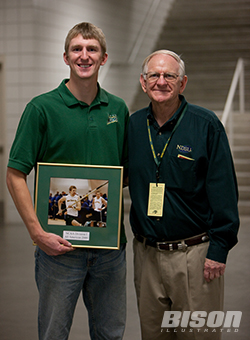

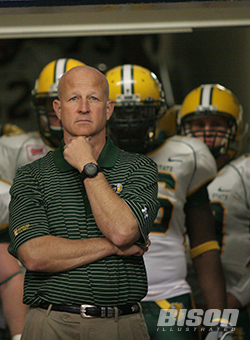
Against the Grain
The Big Three. Chapman. Taylor. Bohl. Their names will forever be etched on North Dakota State University. Without these three men, NDSU does not become what it is today. Period. Say what you will about the circumstances of Chapman and Bohl’s departures. All three should be first-ballot NDSU hall of famers. “Unanimous ballot, no doubt about it,” according to Kolpack. It is easy to look back with rose-colored glasses and forget the struggle and pushback moving to Division I entailed. Like Chapman calling Taylor at home one night and telling him the Big Sky rejected NDSU’s bid for conference membership. Taylor is now the deputy director of athletics for the University of Iowa. Kolpack caught up with him when both were in Seattle for the NCAA Men’s Basketball Tournament in March 2015. Iowa and NDSU were sent to that regional pod by the men’s basketball selection committee that year.
“When we were talking in Seattle, his voice was real, almost still sad, still real deliberate, and you can almost still sense the disappointment,” in that rejection by the Big Sky, said Kolpack of Taylor. “That was, what, in ’05 and 10 years later you can still sense the disappointment in his voice. Like it happened yesterday, that’s how emotionally tied [Taylor] was to that school.” The Bison announced the move to Division I on August 30, 2002, beginning DI play in 2003. When NDSU finished the 2002 season with a 2-8 record, finishing at the bottom of the NCC, there were few thoughts of Division I championships in the near future, if at all. The vultures circled, ready for the kill. That all changed with one game in Missoula, Mont., on September 6, 2003, and the arrival of Bohl, hired by Taylor with the support of Chapman.
“Craig was a masterful builder, just masterful how he could see the vision, but I think it all starts with Joe Chapman. I mean that guy, somebody, and I say it in the book, somebody needed to do it, somebody needed to take the risk and say this is what you are going to do, so I think it all starts with Chapman,” said Kolpack. Chapman and Taylor decided the future of Division II was no future for the Bison. For his part, in the early 2000s, Kolpack thought of getting out of the sports journalism business. “I was thinking about getting out of the business because it just wasn’t fun anymore to cover. I always wanted to cover Division I football and it came to me.” The course of Bison football, NDSU athletics, and, arguably, NDSU as an institution, changed that September afternoon in Missoula.
Bohl, in his second game as head coach, took his team to Missoula for a showdown with FCS powerhouse and perennial title contender Montana. Before NDSU, Montana was the gold standard of the FCS. Trailing 24-2 at halftime, the Bison rallied for a 25-24 win, changing in an instant any reluctant boosters and alums that questioned the Division I move. “I think that’s the jumping off point and really got some people to think maybe I-AA isn’t so far-fetched after all.” It also helped open checkbooks as boosters began to see the potential in their alma mater being a D-I program.
When you’re talking names to remember in building towards the FCS championships, one guy you shouldn’t forget is Mike Weiser. If you want to point to a single play that altered the course of Bison football history, it wasn’t a touchdown plunge against Kansas State or a game-winning, national-title clinching run against Illinois State, however spectacular those plays were. Those plays, Brock Jensen’s touchdown dive in Manhattan, Kan. that sealed the win over the Wildcats and brought “College GameDay” to Downtown Fargo, and Carson Wentz’s epic late-game touchdown against the Redbirds have their special place. So too does the play in Missoula made by Weiser.
The 6-foot-4-inch, 238-pound senior from LaCrescent, Wisc., made “the catch” that started the whole thing. “Mike Weiser. The players that knew him, I’m sure it’s not lost on them. I think that one play is what turned it. If I could point to one play that was most important through this whole process, it was Weiser going horizontal in Missoula, catching that pass from [Rod] Malone, who wasn’t even supposed to throw it in the first place.” Trailing 24-19 with two minutes and change left in the fourth quarter, the Bison opted to line up for the field goal near the Griz’s 20-yard line. On the snap, Malone pealed around the line, taking a pitch going to his right. NDSU called for the fake field goal. Although Malone could have easily run for the first down to extend the drive, or hit a short pass to Jamel Thomas, he pulled up near the line of scrimmage and lofted a pass towards the back right corner of the end zone. The ball looked like it was overthrown, would hit the grass, and the Bison would come up agonizingly short.
“Then when he threw it, when the play happened, when he threw it, Craig thought run it, you know, run it, it’s wide open, you got the first down. And when he saw him throw it, he just turned around and said that’s it, it’s over. The next thing you know, he hears this kinda reaction, he got it. I think that one play is, can never be forgotten.” The photo in the Forum with Taylor embracing Bohl said it all. The Bison meant business. “How Gene picked Craig over Gus [Bradley], I would, everybody would have taken Gus,” said Kolpack, referring to then-Bison assistant Casey “Gus” Bradley, a former NDSU player and player-favorite that is now the head coach for the NFL’s Jacksonville Jaguars. The choice for the NDSU coaching position after Bob Babich left to coach linebackers for the St. Louis Rams before the 2003 season came down to those two–Bohl or Bradley. Taylor went with Bohl.
“Gene went against the grain, which turned out to be the right decision. He saw something in Craig, I guess maybe it was his FBS experience or whatever, but he just went against the grain. Good leaders have to do that once in a while. Chapman went against the grain. Gene went against the grain. You got to have guts to make those decisions.” Ten years later, Taylor would make another coaching decision when Bohl departed for the University of Wyoming, going with NDSU’s defensive coordinator, Chris Klieman, as the next head coach for the Bison. If you’re ever playing a blackjack or craps table in Las Vegas, consider inviting Taylor. By many accounts, the Bison were at their apex when Bohl departed. All Klieman has done since taking the reins is win two straight national titles, kept the program operating at the highest of levels and positioned to contend for another title this season, proven himself one of the ablest coaches in college football in his own right, and produced the second overall pick in last spring’s NFL Draft in Wentz, along with other NFL players like Kyle Emanuel, John Crockett, and Joe Haeg.
“Klieman has obviously done his own stuff, but nothing really surprised me about that. It’s hard to stay on top, but they somehow find a way to avoid the complacency.”
Right Team, Right Time, Right Writer
The plan called for “Horns Up” to be done in time for the 2015 opener at Montana. “There were a couple people I wanted to talk to and couldn’t,” said Kolpack. With the season fast approaching, Kolpack pressed paused and focused on the upcoming campaign. “I shelved it for the year and look what happens.” What happened was NDSU becoming the first team in college football history–in any division–to win five straight championships. With the uncertainty in college football, between injuries, coaches leaving, upsets, and the highly competitive world of recruiting, it’s a feat likely to never be repeated by any other program. As if the story couldn’t get any better, Wentz then becomes a draft phenomenon, ascending the ranks of college quarterbacks that, by the 2016 NFL Draft, he’s the buzz of the sports world along with Cal’s Jared Goff.
But with the Bison starting with two losses in their first six games, the trip back to Frisco for a shot at the five-peat was far from certain. “I’m thinking, timing is everything and I missed that wave of four in a row especially when Carson got hurt, this is not going to turn, I don’t know, that book project, I kind of put it off.” The Bison proved the gift that just keeps on giving. Easton Stick enters the picture and keeps the title train on the tracks, going 8-0 as a starter and leading NDSU to huge playoff wins against Montana, Northern Iowa, and Richmond. The Bison defense progressed through the year to finish as the best unit in the country. It gave Kolpack’s book yet another dimension, from four-peat to five-peat. “And then Stick starts winning.” And winning. “I had pretty much everything done up until this past season [2015], and then Wentz, the NFL Draft stuff hits, and then the season really turns into something crazy.” The timing couldn’t have been better. “The fact I couldn’t finish it after four in a row, that was just pure luck on my part, how fortunate that all of a sudden this project ends up being about the greatest dynasty ever.”
The greatest dynasty ever. Nobody had won five national championships in a row. Not the great Oklahoma teams, not Southern California, Notre Dame, Florida State, or even Alabama. Only one team, ever, in history, can lay claim to winning five college football championships in a row – North Dakota State. “When they won the fifth and nobody had ever done it, I guess it was meant to be,” reflected Kolpack, pausing, then offering, “Or maybe old Ed Kolpack up above.” That link. Father and son. Three decades of excellence to five decades of excellence. It takes a dynasty to cover a dynasty.
“At times, I think back and I remember him writing it (“Three Decades of Excellence”) and it’s just a cool connection inwardly between, I’m not saying, you know, I hear his voice, but just to keep his memory alive is so big for me because it’s been so long. It’s important for my family.” Like father, like son. And, just like the Bison, only one author can lay claim to writing the book telling the story of how college football’s greatest dynasty ever was born.

